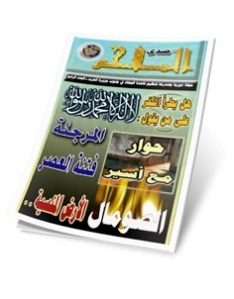
The image is an e-cover of the AQAP magazine Sada al-Malahim [echo of epic battles], issue 4, 1429 A.H. [2008 C.E.]. At the top, under the name Sada al-Malahim the caption reads: “majalla dawriyya yusdiruha tanzim al-qa`idat al-jihad fi janub jazirat al-`Arab” [“a periodical published by Qa`idat al-Jihad (the jihad base) in the Southern Arabian Peninsula”]. The same caption appears in the AQAP logo in the top right corner – a globe with the Arabian Peninsula landmass, a black banner bearing the shahada (Islamic testimony of faith – There is no god but Allah and Muhammad His messenger) with the seal of the Prophet and two crossed Arabian swords.
The captions in the image are the titles of some of the articles included in the issue (from top to bottom): “hal yatra’ al-kufr `ala man yaqulu ‘la ilaha illa Allah wa-muhammad rasul Allah’?” [“Can kufr (infidelity/godlessness) suddenly befall on someone who utters the shahada?”]; “hiwar ma`a ‘asir” (“a conversation with a prisoner”); “al-murji’a fitnat al-`asr” [“the Murji’a are the fitna (civil strife) of this age”]; and “al-sumal al-ard al-mansiyya” (“Somalia – the forgotten land”). The Murji’a (or Murjites) mentioned here refers to a theological school that emerged in early Islam in opposition to the Kharijites on questions related to controversies regarding sin and definitions of what constitutes a true Muslim (for example cf. Ibn Taymiyya, Fatawa, vol. V, 555-557). Murji’ites advocated that only God has the authority to judge who is a true Muslim and who is not, and that Muslims should not exclude other Muslims from the greater Islamic umma (community/nation).
 Skip to content
Skip to content
